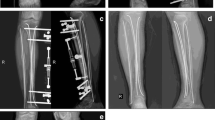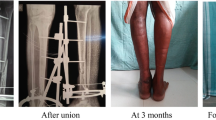Abstract
Traditional external fixator techniques do not always correct minor residual malalignment. We asked whether using a one-wire method that corrects minor malalignment with an olive traction wire placed in the plane of the deformity allowed (1) uniform healing, (2) proper alignment, and (3) adequate reduction of fracture gaps. We retrospectively evaluated 72 patients in whom we used closed tibial fracture reduction using a circular external frame. We identified the plane of the residual deformity after alignment on a traction table using a C-arm. In this plane, the final correction was performed with traction through an olive wire. Satisfactory alignment (less than 3° deviation from normal) was obtained in 68 of the 72 patients (94%), and satisfactory reduction (gaps less than 2 mm) attained in 51 (71%). In no case was the fracture site opened surgically. Four patients underwent additional alignment correction with conical washers outside the operating room but no other efforts were needed to obtain further reduction after the initial surgery. Fractures healed in an average of 20 weeks. We observed no major infections. The Ilizarov frame has been a valuable tool to achieve alignment and anatomic or near anatomic reduction of closed tibial fractures.
Level of Evidence: Level IV, therapeutic study. See the Guidelines for Authors for a complete description of levels of evidence.


Similar content being viewed by others
References
Aronson J, Harp J. Mechanical considerations in using tensioned wires in a transosseous external fixation system. Clin Orthop Relat Res. 1992;280:23–29.
Boestman OM. Spiral fractures of the shaft of the tibia. Initial displacement ad stability of reduction J Bone Joint Surg Br. 1986;68:462–466.
Catagni M. Treatment of tibial fractures. In: Catagni M. Treatment of Fractures, Nonunions and Bone Loss of the Tibia with the Ilizarov Method. Milan, Italy: MediSurgical Video; 1998:31–64.
Claes L, Augat P, Schorlemmer S, Konrads C, Ignatius A, Ehrnthaller C. Temporary distraction and compression of a diaphyseal osteotomy accelerates bone healing. J Orthop Res. 2008;26:772–777.
Davies R, Holt N, Nayagam S. The care of pin sites with external fixation. J Bone Joint Surg Br. 2005;87:716–719.
Demiralp B, Atesalp AS, Bozkurt M, Bek D, Tasatan E, Ozturk C, Basbozkurt M. Spiral and oblique fractures of distal one third of tibia – fibula: treatment results with circular external fixator. Ann Acad Med Singapore. 2007;36:267–271.
Drosos GI, Bishay M, Karnezis IA, Alegakis AK. Factors affecting fracture healing after intramedullary nailing of the tibial diaphysis for closed and grade I open fractures. J Bone Joint Surg Br. 2006;88:227–231.
Green SA, Harris NL, Wall DM, Ishkanian J, Marinow H. The Rancho mounting technique for the Ilizarov method: a preliminary report. Clin Orthop Relat Res. 1992;280, 104–116.
Hutson JJ. Applications of Ilizarov fixators to fractures of the tibia: A practical guide. Techniques in Orthopaedics. 2002;17:1–71.
Muller ME, Nazarian S, Koch P, Schatzker J. The Comprehensive Classification of Fractures of Long Bones. Berlin, Germany: Springer-Verlag; 1990.
Rödl R, Leidinger B, Böhm A, Winkelmann W. Correction of deformities with conventional and hexapod frames–comparison of methods [in German]. Z Orthop Ihre Grenzgeb. 2003;141:92–98.
Seide K, Wolter D, Kortmann HR. Fracture reduction and deformity correction with the hexapod Ilizarov fixator. Clin Orthop Relat Res. 1999;363:186–195.
Tucker H. Management of unstable open and closed tibial fractures. Clin Orthop Relat Res. 1992;280;125–135.
Acknowledgment
We thank John Birch, MD, for his help in manuscript revision.
Author information
Authors and Affiliations
Corresponding author
Additional information
Each author certifies that he has no commercial associations (eg, consultancies, stock ownership, equity interest, patent/licensing arrangements, etc) that might pose a conflict of interest in connection with the submitted article.
Each author certifies that his or her institution has approved the human protocol for this investigation and that all investigations were conducted in conformity with ethical principles of research, and that informed consent for participation in the study was obtained.
About this article
Cite this article
Lovisetti, G., Bettella, L. A One-wire Method for Anatomic Reduction of Tibial Fractures with Ilizarov Frame. Clin Orthop Relat Res 466, 2940–2946 (2008). https://doi.org/10.1007/s11999-008-0517-8
Received:
Accepted:
Published:
Issue Date:
DOI: https://doi.org/10.1007/s11999-008-0517-8




